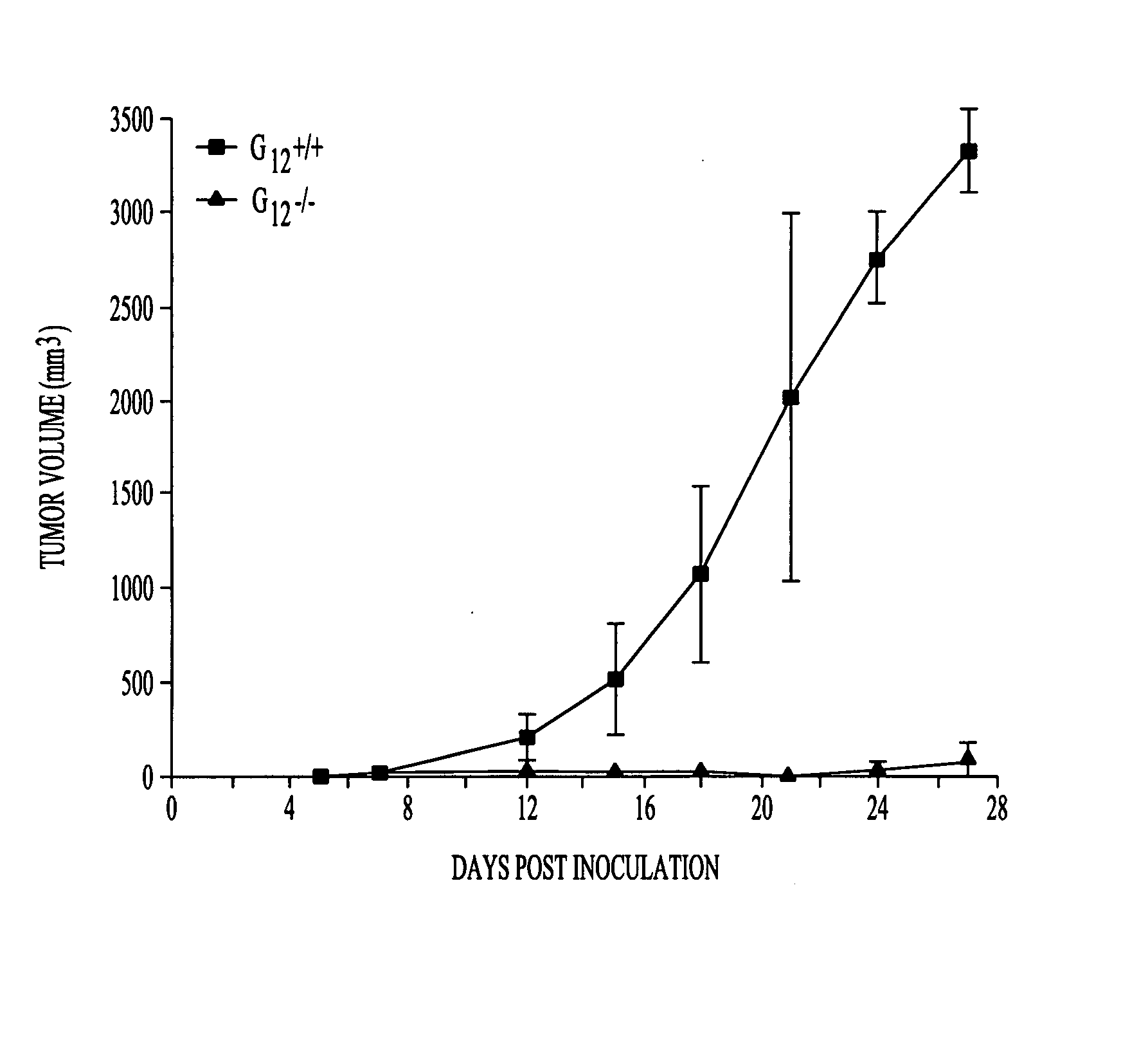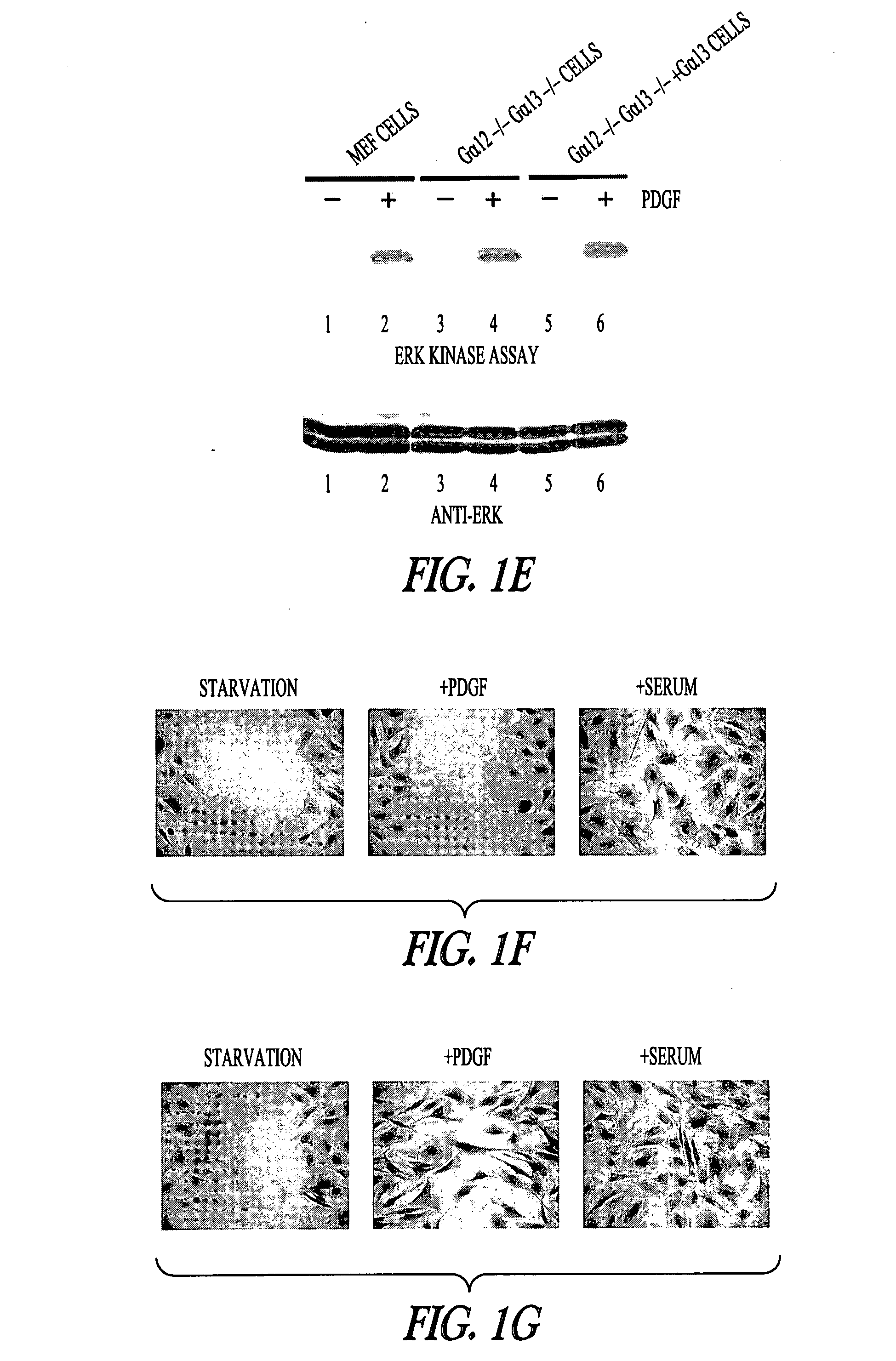G proteins in tumor growth and angiogenesis
a technology of g protein and tumor growth, applied in the field of g protein, to achieve the effect of reducing expression and/or activity of g12 or g13, and reducing tumor growth or cancer cell growth
- Summary
- Abstract
- Description
- Claims
- Application Information
AI Technical Summary
Benefits of technology
Problems solved by technology
Method used
Image
Examples
example 1
Materials and Methods
[0089] Plasmid Constructs: Wild-type and mutant genes encoding human Gα12, Gα13, and Rac cloned in pcDNA3.1 were obtained from Guthrie Research Center. Several Gα13 C-terminal mutants were made. One C-terminal mutant was a truncated protein lacking the last five amino acid residues QLMLQ. A second C-terminal mutant was a similarly truncated protein fused to a Myc tag and a His6 tag at its C-terminus (EQKLISGGDLNMHTEHHHHHH (SEQ ID NO: 5). This Myc / His6 fusion protein was generated by subcloning and expression from a pcDNA3.1-myc-His vector. The third Gα13 mutant had a TAP tag at the C-terminus. Rigaut et al., Nat Biotechnol 17: 1030-1032 (1999). The TAP tag has 184 amino acid residues including a calmodulin-binding peptide, a TEV cleavage site and two IgG binding domains of protein A. The Gα13 / 1-DD1 chimera (in pET28a) was made based on the Gα13 / i-5 chimera (Chen et al., Nat Struct Mol Biol 12: 191-197 (2005)) with the following sequences: amino acid residues 1-...
example 2
Role of Gα13 in RTK-Induced Fibroblast Cell Migration
[0101] In wild-type MEF (mouse embryonic fibroblast) cells, addition of platelet-derived growth factor (PDGF-BB at 20 ng / mL) or serum (10% FBS) induced cell migration (FIG. 1A). Two approaches were used to study the migration of MEF cells, the qualitative wound-healing assay (FIGS. 1, A and B), the quantitative Boyden chamber assay (Shan et al., Proc Natl Acad Sci USA 102: 3772-3776 (2005); Yang and Huang, J Biol Chem 280: 27130-27137 (2005)) (FIGS. 1, C and D). For Gα12− / −Gα13− / − MEF cells (MEF cells derived from the Gα12− / −Gα13− / − mouse embryos), addition of PDGF did not induce cell migration (FIGS. 1, B and D). These Gα12− / −Gα13− / − cells were capable of migrating since addition of serum induced their migration (FIGS. 1, B and D). Furthermore, activation of mitogen-activated protein kinase ERK by PDGF was not affected in Gα12− / −Gα13− / − cells (FIG. 1E). These results suggest that PDGF signaling to cell migration in fibroblast ce...
example 3
Rac Acts Upstream of or in Parallel to Gα13
[0104] To investigate the mechanism by which a heterotrimeric G protein, Gα13, is involved in growth factor-induced cell migration, the relationship of Gα13 was examined with other known signaling molecules downstream of PDGFRs. The Rho-family small GTPase Rac is involved in lamellipodia formation, cell adhesion, and cell migration (Hall, Science 279: 509-514 (1998); Ridley et al., Cell 70: 401-410 (1992); Sugihara et al., Oncogene 17: 3427-3433 (1998)). Genetic evidence has demonstrated that Rac is essential for PDGF-induced cell migration (Sugihara et al., Oncogene 17: 3427-3433 (1998)). As shown in FIG. 4A, dominant negative Rac mutants (Rac1 T17N) reduced PDGF-induced migration of MEF cells. Constitutively-active Rac mutants (Rac1 G12V) induced MEF cell migration in the absence of PDGF (FIG. 4B). These data confirm a role for Rac in PDGF-induced migration of MEF cells. Since both Gα13 and Rac are involved in PDGF signaling to cell migr...
PUM
| Property | Measurement | Unit |
|---|---|---|
| Tm | aaaaa | aaaaa |
| thermal melting point | aaaaa | aaaaa |
| pore size | aaaaa | aaaaa |
Abstract
Description
Claims
Application Information
 Login to View More
Login to View More - R&D
- Intellectual Property
- Life Sciences
- Materials
- Tech Scout
- Unparalleled Data Quality
- Higher Quality Content
- 60% Fewer Hallucinations
Browse by: Latest US Patents, China's latest patents, Technical Efficacy Thesaurus, Application Domain, Technology Topic, Popular Technical Reports.
© 2025 PatSnap. All rights reserved.Legal|Privacy policy|Modern Slavery Act Transparency Statement|Sitemap|About US| Contact US: help@patsnap.com



